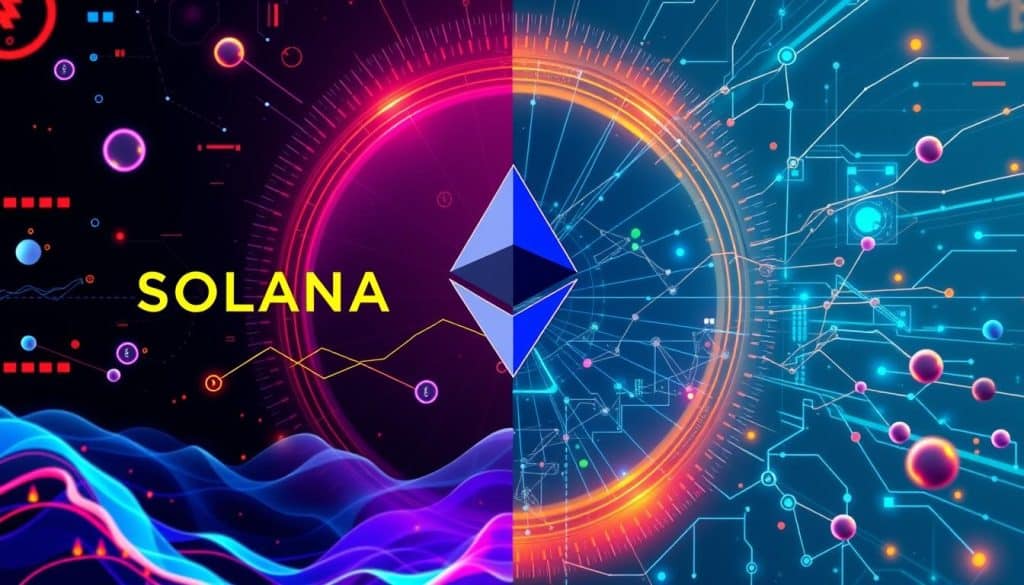Solana can process a stunning 65,000 transactions per second (TPS). Meanwhile, Ethereum’s older Proof-of-Work (PoW) mechanism has put a cap on its speed. This notable difference sparks a lot of discussion among supporters of Solana and Ethereum1.
Wondering which blockchain is right for your investment or project? Our deep dive into Solana versus Ethereum can assist. We’ll look at transaction speeds, ecosystems, costs, and how they handle smart contracts. With this information, you can choose wisely between Solana and Ethereum, two titans of the blockchain world.
Key Takeaways
- Solana can handle 65,000 transactions per second (TPS) compared to Ethereum’s early limitations due to PoW1.
- Solana’s transaction costs are minimal, often just a fraction of a cent, whereas Ethereum’s gas fees can be significantly higher during network congestion1.
- Despite Solana’s swift transaction speed, Ethereum boasts a larger and more established ecosystem with numerous DApps, DeFi projects, and NFT platforms1.
- Ethereum uses Solidity for smart contracts, while Solana supports multiple programming languages including Rust and C1.
- Both Solana’s native token SOL and Ethereum’s token ETH have distinct roles within their networks, powering operations and rewarding participants12.
- Solana’s price was $101.33 on January 1, 2024, contrasting Ethereum’s $2,279.00 on the same date2.
Introduction to Solana and Ethereum
In the expanding universe of blockchain, Solana and Ethereum stand out. Each plays a big role in decentralized applications. They have their special features and abilities.
What is Solana (SOL)?
Solana began in March 2020, known for handling lots of transactions quickly. It targets big challenges like security and scalability in blockchain tech3. By mixing proof-of-history and delegated proof-of-stake, Solana builds a strong home for decentralized apps3. It can do up to 29,171 transactions every second and confirms blocks in about 2.34 seconds, making it super fast4. Plus, it’s cheaper to use than rivals like Ethereum and Cardano3.
What is Ethereum (ETH)?
Ethereum started in 2015, leading the way with smart contracts5. It’s the base for lots of decentralized apps and dApps3. In 2022, Ethereum cut its energy use by 99.9% by switching to proof-of-stake3. It handles 15 to 45 transactions per second and confirms blocks in around 13 seconds4. Even with higher fees at busy times, Ethereum stays popular because of its flexibility and strong community.
Brief History of Both Platforms
Solana quickly became known for its speed and low cost since its 2020 launch, challenging Ethereum5. It raised over $20 million, helping its ecosystem grow4. By 2021, Solana hit nearly $260 as its highest price and had over 350 dApps3.
Ethereum’s story started in 2015, raising $18 million from its ICO4. Its early success made it a top cryptocurrency, with innovations like EIP-1559 and shifting to proof-of-stake in 20224. The Solidity language and its vast application ecosystem keep Ethereum at the forefront5.
Consensus Mechanisms of Solana and Ethereum
Understanding how blockchain networks agree on transactions is key. It ensures transactions are valid and keeps the network safe.
Solana’s Proof-of-History (PoH)
Solana has a special way of reaching consensus called Proof-of-History (PoH). It works with Proof-of-Stake (PoS) to process transactions super fast. They can handle over 65,000 transactions every second6. This method makes things quick and cheap, even when it’s busy7. Solana’s PoH makes a timeline of events that’s easy to check. This speeds up transactions a lot.
Ethereum’s Transition to Proof-of-Stake (PoS)
Before, Ethereum used a method called Proof-of-Work (PoW). It was secure but used a lot of energy and was slow8. Wanting to do better, Ethereum is moving to Proof-of-Stake (PoS) with its Ethereum 2.0 upgrade8. This could let it handle up to 100,000 transactions per second7. It aims to use less energy and solve some growth issues8. Ethereum is strong, thanks to its big community and long history8.
Comparison and Impact on Performance
Comparing Solana’s PoH with Ethereum’s PoS shows clear differences. Solana is really fast now, doing up to 3,000 transactions per second7. Ethereum 2.0 hopes to reach 100,000 transactions per second but is still working on it7. Solana often costs less for transactions. However, Ethereum’s big network and new updates might change things soon6.
Scalability and Speed: Solana vs Ethereum
The solana blockchain and ethereum scalability debate heats up around two main issues: transaction speed and how well they scale. Solana can handle up to 65,000 transactions every second (TPS), which is way faster than Ethereum’s original cap of about 30 TPS9. With its transactions costing just a few cents, Solana is a very appealing choice for those caring about speed and affordability9
Transaction Speed
Solana shines when it comes to transaction speed, leaving Ethereum behind. While Ethereum works on improvements to eventually reach 100,000 TPS, Solana leads with 2,500 to 3,500 TPS10. This edge in speed makes Solana a top pick for fast-paced environments like decentralized finance apps.
Scalability Solutions
Ethereum struggles with network congestion and high fees due to its stateful design9. Solana’s stateless setup, in contrast, helps it scale better and process transactions more smoothly. With Ethereum 2.0 on the horizon, Ethereum plans to up its scalability and speed10. This upgrade should help ease delays and lessen network bottlenecks, bringing it closer in performance to Solana.
Here is a comparison of the scalability and speed:
| Feature | Solana | Ethereum |
|---|---|---|
| Transactions Per Second (TPS) | 2,500 – 3,500 (capable up to 65,000) | Approximately 30 (target up to 100,000 post PoS) |
| Average Transaction Fee | 0.00064 SOL (approx. 0.11 USD) | 1-2 USD post PoS, higher before |
| TVL | Approximately $4 billion | Approximately $49.23 billion |
In conclusion, Solana leads in speed and low fees for now, but Ethereum’s move to PoS could change the game. This transition could allow it to catch up, making it better for decentralized apps.
Costs and Fees on Solana and Ethereum
Transaction costs and fees are key when looking at blockchain tech. Ethereum and Solana have different costs that impact their popularity.
Gas Fees on Ethereum
Ethereum’s gas fees can go really high during busy times. This can be too costly for users doing many transactions11. Still, Ethereum is liked for its strong ecosystem and safety features. The change to Proof-of-Stake (PoS) might lower fees, making Ethereum more appealing11.
Transaction Costs on Solana
Solana is known for its low transaction fees. This makes it a cheaper option than Ethereum. It charges around 0.0001 SOL per transaction11. Solana can handle more daily transactions than Ethereum, showing it can manage more activity with less cost12. It also destroys 50% of each fee, keeping the network safe and balanced13.
Ethereum and Solana have their own benefits. Solana is good for those who want cheap and fast transactions. But Ethereum could be better for those looking for strong security and an established system. As Ethereum moves to PoS, the fee difference between these chains might change, affecting what users prefer.
Security Features of Solana and Ethereum
Blockchain security is vital for Solana and Ethereum, each having its own way to keep networks safe. Their security features show the strengths and challenges of both platforms.
Solana’s Security Measures
Solana uses a mix of Proof-of-Stake (PoS) and Proof-of-History (PoH) for better scalability and security14. This method allows the handling of many transactions per second while keeping the security strong15. Yet, Solana is newer and hasn’t been tested as much as Ethereum, which makes people wonder about its security over time14.
Even with these advanced features, Solana has had some problems with centralization and network downtimes. These issues lead to debates on how to balance speed with secure, decentralized systems15.
Ethereum’s Security and Robustness
Since its launch in 2015, Ethereum is known for being reliable and secure because of its proven security measures14. With its move to Ethereum 2.0, it switched to Proof-of-Stake to make the blockchain safer and fix old issues15. This change also aims to lower fees and speed up transactions16.
Ethereum’s large developer community and solid ecosystem make its security even stronger. It’s a good place for smart contracts and DApps. As Ethereum grows, it’s expected to get even better at handling more users securely14.
Ecosystem and Developer Support on Solana and Ethereum
The strength of a blockchain relies on its ecosystem and support for developers. Let’s look at how Ethereum and Solana stack up in these key areas.
Ethereum’s Extensive Ecosystem
Ethereum leads with a vast ecosystem valued at $387 billion by March 2024, way ahead of Solana’s $76 billion6. It hosts countless dApps, DeFi protocols, and NFT marketplaces15. Developers enjoy plenty of resources and community support, sparking constant innovation9.
Ethereum’s ecosystem is both mature and widely adopted, having a TVL over $50 billion15.
Solana’s Growing Ecosystem
Solana is making waves with its expanding ecosystem. It offers low fees and fast processing, capable of handling over 65,000 transactions per second9. Despite Ethereum’s lead, Solana’s ecosystem is quickly growing, with a TVL of $3.5 billion15.
Its design blends PoS and Proof of History, making the blockchain efficient and scalable9. Furthermore, with nearly 1,700 validator nodes by March 2024, Solana boosts its security and trustworthiness6.
Developer Tools and Resources
Ethereum and Solana both provide rich developer tools and resources. Ethereum’s arsenal includes Truffle, Remix, and Hardhat for easy dApp creation and deployment9. Its vast community offers unmatched support and networking opportunities9.
On the flip side, Solana gives developers access to the Solana Development Suite, easing the creation and management of dApps. Solana’s impressive growth and scalability are attracting more developers, despite it trailing Ethereum’s support and ecosystem.
| Aspect | Ethereum | Solana |
|---|---|---|
| Market Cap (March 2024) | $387 billion | $76 billion |
| Total Value Locked (TVL) | $50 billion | $3.5 billion |
| Transactions per Second | 30 | 65,000 |
| Developer Community Size | Largest | Growing |
| Validator Nodes | – | 1,700 |
| Gas Fees | High | Low |
Smart Contract Capabilities: Solana vs Ethereum
It’s vital to grasp how Solana and Ethereum handle smart contracts for developers. These platforms pick different paths via their languages, Solidity for Ethereum and Rust for Solana.
Ethereum’s Solidity
For blockchain excellence, Ethereum’s Solidity is key. It’s preferred by devs for its strength and adaptability. With a $404 billion market cap, Ethereum’s rich ecosystem is supported by plenty of developers1715. Solidity simplifies crafting complex dApps with its wide library and tools15. Despite handling about 30 transactions a second, its broad use shows it’s chosen often, despite speed limits1715.
Solana’s Rust
In contrast, Solana’s Rust is about boosting blockchain with performance focus. Its Proof of History mechanism processes thousands of transitions quickly outshining Ethereum in speed and throughput1715. Solana has a $63 billion market cap and has shot up by over 450% in a year, unlike Ethereum’s 50%1715. Rust’s performance makes Solana contracts appealing for efficient and cost-effective development.
Performance and Efficiency
Solana wins in performance and efficiency, thanks to its new tech and smarter contract development space. It zooms past Ethereum in transaction speed with its PoH consensus17. Ethereum’s varying gas fees affect users, while Solana ensures cheaper, quicker transactions17. Although Ethereum leads with 62% in total value locked (TVL), Solana has a more active user base daily17. Both serve different needs, offering varied opportunities for projects1715.
DeFi Use Cases: Solana vs Ethereum
In the world of DeFi apps, Solana and Ethereum have unique strengths. Ethereum is a top choice for DeFi projects, with many protocols and a huge user base.
Key DeFi Projects on Ethereum
Ethereum leads in DeFi with its high total value and diverse protocols like MakerDAO and Uniswap. Users enjoy options like lending and trading18. Its programing language, Solidity, may be tough to learn but lets builders make secure contracts18. Ethereum 2.0’s PoS mechanism enhances its security and governance19.
Notable DeFi Projects on Solana
Solana stands out for its fast transactions and low fees. It’s perfect for quick and cheap DeFi apps18. Projects like Serum and Raydium add liquidity. Its consensus method allows tons of transactions, outdoing Ethereum in scalability18. Solana makes it easier for developers with Rust and other languages, speeding up DeFi project launches19
Solana is getting more users every day, outpacing Ethereum in daily active users20. Innovations like Firedancer help process transactions faster, making Solana more user-friendly20. Despite its growth, Solana’s DeFi scene isn’t as developed as Ethereum’s yet19.
Comparing TVL on Solana and Ethereum
When we look at Total Value Locked (TVL) for Solana and Ethereum, we discover important trends in blockchain and DeFi areas. TVL is a vital sign that shows how much money is in a blockchain’s DeFi systems. It tells us about the platform’s financial strength and popularity.
Total Value Locked (TVL) on Ethereum
Ethereum is ahead with a TVL of $59 billion, highlighting its top spot in the DeFi world21. A big reason for this is the huge amount of money platforms like Lido pull in. They bring in almost ten times what the whole of Solana does21. With a big ecosystem and a market cap of $404 billion, Ethereum firmly leads the DeFi scene20.
TVL on Solana
On the other side, Solana has a TVL of $3.5 billion, showing it has room to grow but is also making its mark21. Solana’s top protocol, Jito, has a big part in its TVL with $1.74 billion21. Though smaller in market cap and TVL, Solana shines with high transaction rates and user growth, even passing Ethereum in daily active users per protocol20.
Trends and Insights
Solana is really engaging users, especially with memecoin trades where it sometimes beats Ethereum’s trading volume20. A lot of new folks are joining Solana, mainly because of DeFi. These patterns show that while Ethereum has a big part of the DeFi world with 62%, Solana is on a path of growth20.
Here’s a quick table showing how Ethereum and Solana stack up:
| Metric | Ethereum | Solana |
|---|---|---|
| Total Value Locked (TVL) | $59 billion21 | $3.5 billion21 |
| Leading Protocol’s TVL | Lido: High capital attraction | Jito: $1.74 billion21 |
| Market Capitalization | $404 billion20 | – |
| User Growth | – | Higher daily active users per protocol20 |
| DEX Trading Volume | Lower in memecoin segment | Often exceeds Ethereum’s20 |
Ethereum and Solana both shine in their ways while Ethereum stays on top of the DeFi world, Solana’s numbers show it has a bright future. Their different ways of scaling and innovations focused on users paint a dynamic, growing landscape.
Token Utility: SOL vs ETH
Comparing SOL and ETH shows how essential they are to their systems. Both play crucial roles in their own networks. This look into their functions reveals their unique benefits and uses.
Functionality within Their Ecosystems
ETH is more than just a currency in Ethereum; it’s like “gas”. It helps with transactions and pays validators. On the other hand, SOL in Solana is key for staking and paying fees. This highlights how vital ETH and SOL are for their blockchains’ operations and safety.
Staking Rewards
Staking in Ethereum is significant, but Solana sees even more action. A whopping 65.7% of SOL tokens are staked, compared to Ethereum’s 27.8%. This high number shows a deep trust in Solana by its users22. It strengthens the network and builds investor confidence.
Usage in Transactions
SOL and ETH are key, yet they differ in how transactions work. Solana’s fees are super low, at just $0.00025. Compared to Ethereum’s $16.3723, that’s a big difference. This makes Solana better for many transactions. Plus, Solana can handle 65,000 transactions per second, while Ethereum does just 1523.
This means a lot for those making many crypto transactions. These differences in transactions can change how users experience each network. Whether staking in Solana or using Ethereum’s big ecosystem, each token is key to decentralized finance and blockchain apps.
Looking for a good Ethereum wallet? You might want to check out the best Ethereum wallet solutions out there.
SOL and ETH aren’t just for transactions. They’re core to the working and growth of Solana and Ethereum. Their special roles make them valuable in the digital finance world.
Latest News and Developments
Keeping up with the latest in cryptocurrency is key for fans and investors alike. Big news has come from the Ethereum and Solana worlds. These updates are making big changes and helping blockchain technology grow.
Recent Updates on Ethereum
Ethereum is moving to Ethereum 2.0, a huge step forward. This update will make it work better and solve some big problems. There’s also talk of a new ether spot ETF coming. This could shake up the market just like the Bitcoin ETF did recently24. People are also watching the SOL/ETH chart closely. It might predict a drop in value24.
Current Events in Solana Ecosystem
Solana is getting a lot of attention for its new projects. One project, a memecoin launchpad called pump.fun, brought in more than $100 million in just six months25. Over 30,000 people have also started using Solana more, putting in about $30 million25. Plus, it’s easy for developers to work with. They can use tools they already know without starting from scratch25.
Future Outlook for Solana and Ethereum
The future of blockchain innovation relies heavily on platforms like Ethereum and Solana. They are both making big changes and upgrades. Their work aims to lead the way in the cryptocurrency world.
Ethereum 2.0 Roadmap
Ethereum is getting a major upgrade called Ethereum 2.0. This upgrade will improve its scalability, security, and sustainability. The change from Proof-of-Work (PoW) to Proof-of-Stake (PoS) will make it more eco-friendly. It will also help increase the speed of transactions. To sum up, this upgrade is expected to strengthen Ethereum’s market position, attracting more developers and investors.
Solana’s Future Prospects
Solana joined the cryptocurrency scene in 2020, starting at $153.88. It hit its peak at $260 on November 6, 202126. In 2022, its value fell by over 90% due to various challenges, like the FTX collapse. But, it showed resilience26. On August 7, 2024, Solana’s trading price was $152.86, with a market cap of $71.60 billion26. As of June 6, 2024, it had surged above $170, marking a 300% increase in a year27.
Experts believe Solana might reach $200 by late 2024 and could go over $300 by 202526. It’s doing well in the DeFi sector, boasting $4.4 billion in total value locked. Its trading volume also competes strongly against Ethereum26. Solana’s success in the NFT market comes from its ability to handle many transactions at low costs. This success has attracted a lot of developers and projects.
Solana’s ability to stay high-performing while tackling scalability and decentralization is crucial. If it keeps this up, its prices could soar between $886.35 and $1,672.15 from 2026 to 203026. The tech paths for both Ethereum and Solana offer different chances and hurdles. They could significantly change their roles in the crypto world.
Discover more insights into Solana’s potential as it keeps innovating and grabbing the market’s attention.
Solana Ethereum Comparison in Detail
When we look at Solana and Ethereum, each one shines in its own way. Both have unique strengths to consider.
Strengths and Weaknesses
Solana is super fast, handling up to 50,000 transactions every second. Ethereum, before updating, could do 30 per second but now may reach 100,0001510. This speed is a big deal for those wanting quick, cheap transactions, especially when the network is busy16.
On the other hand, Ethereum is known for its big ecosystem and long history. It has a huge community of developers supporting it15.
Solana, though, gets flak for not being as spread out (only 3/10 for decentralization). It also has had some problems keeping its network stable10. Ethereum’s issues mainly come from its high fees, which can hit $50 during busy times15. Still, with its upgrade to Ethereum 2.0, it’s working on getting better and greener16.
Investment Considerations
Choosing between Solana and Ethereum for investing means looking at risks and possible gains. In 2023, Solana’s returns hit 450%, while Ethereum’s were at 50%15. Yet, Ethereum leads with a market cap of $360 billion, dwarfing Solana’s $60 billion1510. Ethereum’s DeFi scene is also huge, with over $50 billion locked in, compared to Solana’s $3.5 billion15
Ethereum stays on top as a reliable pick because of its market lead and switch to proof-of-stake. Solana, though riskier due to its smaller market share and shakey network, offers the lure of bigger rewards16.
Developer and User Perspectives
Developers might lean towards Solana for its speed and lower fees. These perks make it great for building affordable apps1016. Ethereum, though, thanks to its vast tools, strong decentralization (7/10 rating)10, and support network, is perfect for creating a wide range of complex dApps1516.
From the user’s standpoint, Ethereum might be pricey at peak times16. Solana users, though, enjoy steady low fees. This makes using the blockchain more affordable and accessible10.
- Transaction Speed: Solana – Fast, Ethereum – Variable
- Gas Fees: Solana – Low, Ethereum – High
- Ecosystem: Ethereum – Extensive, Solana – Growing
- Decentralization: Ethereum – Above average, Solana – Weak
- Stability: Ethereum – Generally stable, Solana – Low
Conclusion
The choice between Solana and Ethereum is big for folks into blockchain choices or planning crypto investments. Ethereum has been a heavy hitter since 2015, with a massive $316 billion market cap and big partnerships like Microsoft and JPMorgan Chase28. Solana, popping up in 2020, quickly made a name with its speedy transactions and lower fees28.
In terms of handling transactions, Ethereum can do up to 35 per second. Solana, however, can manage a whopping 5000 per second29. This huge difference shows they serve different needs in scalability and use. Still, both are key players in DeFi, with Ethereum’s Total Value Locked (TVL) at $117.2B and Solana’s at $7.58B29.
Choosing between Solana and Ethereum comes down to what you value most. If it’s cutting-edge and scalable solutions, Solana, with partners like Circle and Google, might be your pick28. If you lean towards a broad, well-established ecosystem, then Ethereum could be for you. Whichever you choose, both are set to keep impacting the world of blockchain.








